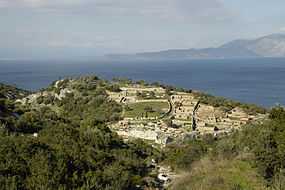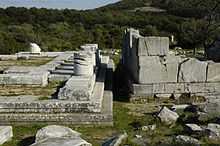Rhamnous
| Rhamnous Ραμνούς | |
|---|---|
 View of the site of Rhamnous with Euboea in the background | |
 | |
| Alternate name | Ramnous, Rhamnus |
| Location | Agia Marina, Attica, Greece |
| Region | Attica |
| Coordinates | 38°13′24″N 24°1′38″E / 38.22333°N 24.02722°ECoordinates: 38°13′24″N 24°1′38″E / 38.22333°N 24.02722°E |
| Type | Settlement |
| History | |
| Periods | Hellenistic |
| Satellite of | Athens |
| Site notes | |
| Condition | Ruined |
| Ownership | Public |
| Management | 2nd Ephorate of Prehistoric and Classical Antiquities |
| Public access | Yes |
| Website | Ramnous |
The site of Rhamnous (Greek: Ῥαμνοῦς), also Ramnous or Rhamnus, was an ancient Greek city in Attica. It was situated on the coast, overlooking the Euboean Strait. Its ruins are found northwest of the modern town Agia Marina in the municipality of Marathon in the modern region Attica, Greece.
Rhamnous was strategically significant enough to be fortified and receive an Athenian garrison of ephebes (young men). A fortified acropolis dominates the two small harbors, into which grain was imported for Athens during the Peloponnesian War. These harbors are located on either side of the fortified hill and have extensively silted up since antiquity. The site was known in Antiquity for its sanctuary of Nemesis,[1] the implacable avenging goddess whose sanctuary here was the most important one dedicated to her in ancient Greece. Many grave monuments have been recovered from burials along the road between Rhamnous and Marathon, on which the sanctuary was also sited.
The sanctuary of Nemesis

On the road between Rhamnous and Marathon, around 630m south of the fortified deme site, there was a sanctuary of Nemesis built between 438 and 431 BC on a platform with a well-built 44m terrace wall at 38°13'3.88"N, 24° 1'37.07"E. During its time of use the sanctuary was not isolated, but rather was in close proximity to a number of houses and other structures scattered in the vicinity. In the Roman period c. 46 CE, dedications were made to the deified Livia, the wife of Augustus, and to the emperor Claudius. In the 2nd century CE, Herodes Atticus made dedications of busts of the emperors Marcus Aurelius and Lucius Verus as well as a statue of his pupil Polydeucion. The cult of Nemesis at Rhamnous came to a formal end with the decree of the Byzantine emperor Arcadius in 382 CE that ordered the destruction of any surviving polytheist temples in the countryside.[2]
Early 5th century BCE small temple

In the early 5th BCE, a small sanctuary (6.15 by 9.9m) was built to both the goddesses Themis and Nemesis. Pottery found under the temple dates no later than the early 5th BCE. There are several cuttings on the steps of this temple for the insertion of stelai. The temple was built of local dark marble and roofed with terracotta tiles. The walls of the cella and the terrace wall of the sanctuary platform are built in the Lesbian polygonal style of masonry.
Based on the dedicatory inscriptions on two marble seats of the 4th century BCE that were sited on the porch, that temple is thought to have really been jointly dedicated to both Nemesis and Themis. This may show that Themis was originally venerated here in conjunction with Nemesis: one the personification of Right Order and the other the avenger of Order's transgressors. This structure survived into the 4th century CE. A statue of Themis and several other dedications, unearthed in the cella, are at the National Archaeological Museum, Athens.
Late 5th century BCE large temple

The destroyed late 6th BCE poros temple was functionally replaced by a 6 × 12 Doric peripteral temple in the late 5th century BCE measuring 10.05 by 21.4m. The euthynteria and lowest step of the crepidoma were made from local dark marble, while the rest was constructed of white marble. There were no pedimental sculptures, nor were the metopes decorated with sculpture. The roof was decorated with sculptural acroteria, however. For unknown reasons the carving of the flutes on the columns was not done. The stylobate blocks were left unfinished, retaining the protective excess marble over their easily damaged corners and upper surfaces.
The cella of the new temple housed the cult figure of Nemesis alone, carved by Agorakritos, a pupil of Phidias, from the block of Parian marble alleged to have been brought by the overconfident Persians for their triumphal stele. The famous statue [3] of the goddess stood within the cella of the temple and was around 4m high. The Roman historian and connoisseur Varro rated it the finest example of Greek sculpture (Pliny). The base has been reconstructed from the hundreds of fragments that were found scattered about after the destruction of the cult image by early Christians. On three sides of the base, the nearly-in-the-round scene shows the presentation of Helen to her mother Nemesis by Leda.[4] The base was capped with a course of dark Hymettian marble.
Rhamnous deme site

Occupying a c. 28m high hill between two bays, the fortified site of Rhamnous covered a site of approximately 230 by 270m. The fortification walls were constructed of the local marble from Agia Marina. As has been noted above, there were significant numbers of structures and inhabitants outside the walls of the fortified area.
Images
-
Temple of Nemesis
-
Temple of Nemesis
-

Map of Rhamnous
-
General view of Rhamnous
-
Closer view
-
Main path
See also
- National Archaeological Museum of Athens
Notes
- ↑ Described by Pausanias 3.3.2.
- ↑ Si qua in agris templa sunt, sine turba ac tumultu diruantur. His enim deiectis atque sublatis omnis superstitioni materia consumetur., Codex Theodosianus,Liber XVI,X.16
- ↑ Pliny's Natural History Pliny 36.17.
- ↑ As is frequently the case, there were competing versions of the Greek myth (story).
References
- Despinis, G. "Discovery of the Scattered Fragments and Recognition of the Type of Agorakritos' Statue of Nemesis." AAA 3 (1970), 403-414.
- Dinsmoor, W.B. Jr. "Rhamnountine Fantasies," Hesperia 30 (1961), 179-204.
- Edwards, C.M. "Tyche at Corinth," Hesperia 61 (1990), 529-542.
- Hodge, A.T. and R.A. Tomlinson. "Some Notes on the Temple of Nemesis at Rhamnous," AJA 73 (1969), 162-185.
- Karusu, S. "Ein Akroter klassischer Zeit" AthMitt 77 (1962), 178-190.
- Langlotz, E. "Eine Metope des Nemesistempel in Rhamnus" in Scritti in onore di Bartolomeo Nogara. Vatican City, 1937, 225-230.
- Lapatin, K.D.S. "The Reconstruction of the Temple at Rhamnous? Who is who on the Nemesis Base?" Hesperia 61 (1992), 107-119.
- Leake, William Martin. Travels in the Morea vol. II (London 1830)
- Miles, M.M. "The Reconstruction of the Temple of Nemesis at Rhamnous", Hesperia 58 (1989), 134-256.
- Petrakos, V. Rhamnous. Athens, 1991.
- Stillwell, Richard, ed. Princeton Encyclopedia of Classical Sites, 1976: "Rhamnous, Attica Greece"
- Thompson, H.A. "Athens Faces Adversity." Hesperia 50 (1981), 346-348.
- Travlos, J. Bildlexikon zur Topographie des antiken Attika. Tubingin, 1988, 388-403.
- de Waele, J.A.K.E. "The Design for the Temple of Nemesis at Rhamnous," in M. Gnade, ed., Stips Votive, Papers Presented to C.M. Stibbe. Amsterdam, 1991, 249-264.
- Wilhelm, A. "Themis und Nemesis von Rhamnous." OJb 44 (1942), 200-209.
External links
| Wikimedia Commons has media related to Rhamnous. |
- Official website
- Perseus site
- ODYSSEUS (Hellenic Ministry of Culture) - Rhamnous
- Classical Backpacking in Greece
| |||||




